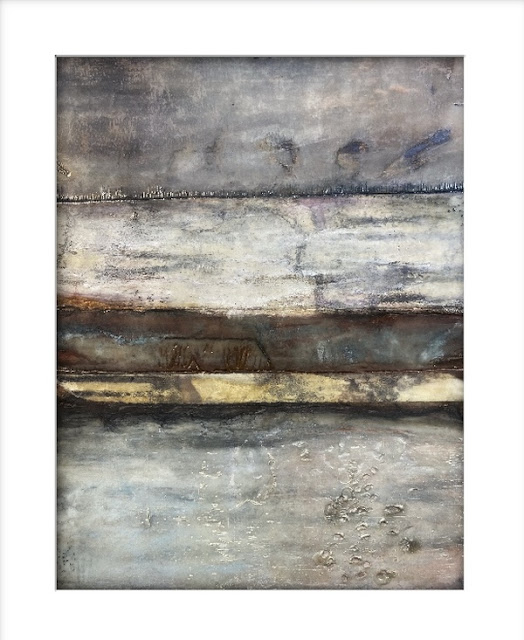.jpg) |
| Chain of Events, encaustic monotype on Sumi-e paper |
Part 40 of an interview series in which artists reply to the same six questions. Michelle Hernandez, based in New Jersey, USA, works with encaustic to create monotypes and mixed media work that take full advantage of the rich range of mark making and depth of surface made possible by those materials. You can see more of her work here. Other interviews on this blog are available here.
Philip Hartigan: What medium/media do you chiefly use, and why?
Michelle Hernandez: My primary medium is encaustic painting and encaustic monotype printing which I then turn into mixed-media collages (usually). I practiced as an interior and industrial designer for years and wanted to embark on a medium which really fed into my need for tactile manipulation. I’m a very hands-on person. As I researched different mediums, the encaustic process intrigued me; it’s a 4,000 year old medium once used by Romans and Egyptians in various forms. It’s a mash-up of ancient and modern techniques. It uses natural materials: beeswax, pigmented beeswax, damar resin (from trees found in Asia). The alchemy of melting, color mixing, fusing with fire or heat, carving, mark-making and excavating became a meditative way for me to slow down, stay in the moment and practice patience. With encaustic monotypes, the immediacy of painting on a hot palette and then printing the image onto paper feeds my impatient traits (I can print 50 to 100 in a few hours.)
PH: What piece are you currently working on?
MH: Currently I am working on a series of abstract landscapes/inner landscapes, inspired by land formations, the ocean, travel. I’m exploring the contrast of the ever-changing external landscape to how we then process it internally.
 |
| Untitled, encaustic and oil stick on birch panel |
PH: What creative surprises are happening in the current work?
MH: The current series has me re-evaluating my website and my social media posts. I'm also using my design skills to edit, edit, edit in order to get down to the essentials of color, shape, form and detail. I’m currently taking an intensive workshop on monotypes and my brain is hurting with so much new knowledge - it's so exciting!
PH: What other artistic medium (or non-artistic activity) feeds your creative process?
MH: Music completely feeds my process - all genres. Travel, food, museums and nature are my go-to’s for inspiration - shared experiences as well as deeply personal experiences. Photography is something I enjoy and use my iPhone as my portable sketch pad to capture nature, a color, a texture or architectural details.
 |
| from the Inner landscapes series, encaustic monotype/mixed media collage printed on Sumi-e paper & mounted on birch panel |
MH: I don’t remember the first piece of art, but I’m sure it was drawing with crayons while watching cartoons. I do remember winning an art contest in third grade for a poster on the importance of reading that was displayed in the public library. It was the first public recognition of something I had created from my head, heart ,and hands. I still call upon that feeling whenever I’m about to put myself/art out there or apply for an exhibit - the 9 year old me is pretty confident!
PH: Finally, and you can answer this in any way that's meaningful to you: why are you an artist?